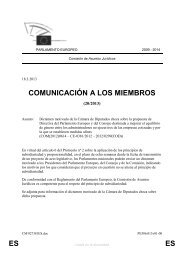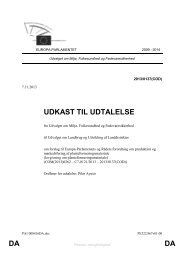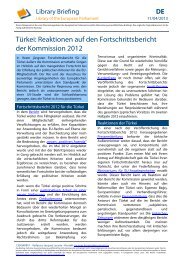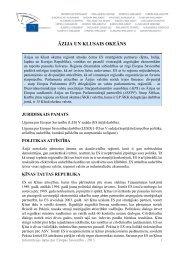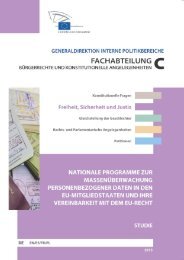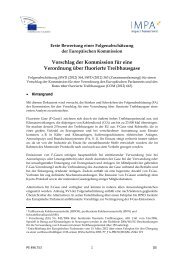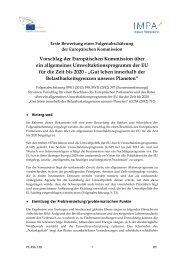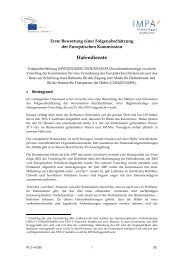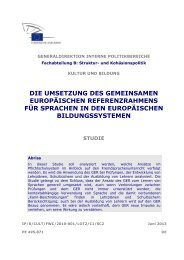Link to the study - European Parliament - Europa
Link to the study - European Parliament - Europa
Link to the study - European Parliament - Europa
Create successful ePaper yourself
Turn your PDF publications into a flip-book with our unique Google optimized e-Paper software.
Nuclear Decommissioning: Management of Costs and Risks<br />
____________________________________________________________________________________________<br />
The products of <strong>the</strong> plasma oven and secondary waste produced have <strong>to</strong> be disposed as radioactive<br />
waste. Elevated (i) investment costs; (ii) operating costs (electricity); and (iii) technological sensitivity<br />
and risks, are only balanced by <strong>the</strong> high volume reduction fac<strong>to</strong>r if packaging and disposal of <strong>the</strong><br />
waste is extraordinarily expensive.<br />
As Bulgaria is currently following a concept <strong>to</strong> dispose <strong>the</strong>se waste categories in a surface near<br />
disposal facility, <strong>the</strong> volume-specific disposal costs are low <strong>to</strong> moderate compared <strong>to</strong> o<strong>the</strong>r disposal<br />
methods. The advanced volume reduction of 6 <strong>to</strong> 7 : 1 (Shuey 2006) is less relevant, e.g. compared with<br />
<strong>the</strong> less cost intensive and technically more robust (high-pressure) compaction methods that achieve<br />
a reduction fac<strong>to</strong>r of up <strong>to</strong> 5 : 1 (WNA 2013).<br />
4.9.3. Second failure <strong>to</strong> identify decision makers<br />
We have asked different communication partners <strong>to</strong> better understand how this decision was actually<br />
taken. Our respective question <strong>to</strong> EBRD was (see ANNEX 7):<br />
'How could it happen, and what was EBRD’s responsibility in that case, that a completely<br />
inadequate plasma oven was ordered and built as part of <strong>the</strong> decommissioning project, while <strong>the</strong>re<br />
is no technical and economic benefit at all from that facility? How was <strong>the</strong> plan technically and<br />
economically evaluated, and on which grounds, if this contributes anything <strong>to</strong> <strong>the</strong> decommissioning<br />
progress? What were <strong>the</strong> check mechanisms in that case? What failed here and why did it fail?'<br />
(ANNEX 7)<br />
EBRD’s answer <strong>to</strong> <strong>the</strong>se questions was:<br />
'The decommissioning strategy for Kozloduy Units 1-4 foresees <strong>the</strong> conditioning of solid radioactive<br />
wastes with a high volume reduction fac<strong>to</strong>r. The technical specification issued for tender did not<br />
prescribe any specific technology. The market response <strong>to</strong> an open competitive tender resulted in<br />
proposals using plasma melting technology – not only by <strong>the</strong> winning bidder. During project<br />
implementation, no particular risks were identified with regard <strong>to</strong> plasma melting and its associated<br />
technologies. The technical design, <strong>the</strong> detailed design and Intermediate Safety Analysis Report<br />
(ISAR) have been approved by Kozloduy NPP. The ISAR went through independent verification<br />
review and received a positive conclusion. The technical design and ISAR are currently under final<br />
review by <strong>the</strong> nuclear regula<strong>to</strong>r, which includes review by international experts funded from <strong>the</strong><br />
KIDSF. The Environmental Impact Assessment Report was approved by <strong>the</strong> Ministry of Environment<br />
and Water on 30 May 2013 and public hearings are planned for July-August.' (ANNEX 8)<br />
Even though explicitly asked, <strong>the</strong> 'thorough reviews' are not named. The 'approvals' mentioned<br />
include only institutions that are not responsible for technology selections but solely for radiological<br />
and environmental issues.<br />
The exact definition of 'high volume reduction fac<strong>to</strong>r', which in this case is prescriptive, limits and<br />
practically determines applicable technologies, again was nei<strong>the</strong>r explained fur<strong>the</strong>r nor reasoned.<br />
The risk that an experimental technology can fail and result in delays or requires time-consuming<br />
backfittings was not identified by EBRD:<br />
'During project implementation, no particular risks were identified with regard <strong>to</strong> plasma melting<br />
and its associated technologies.' (ANNEX 8)<br />
127




